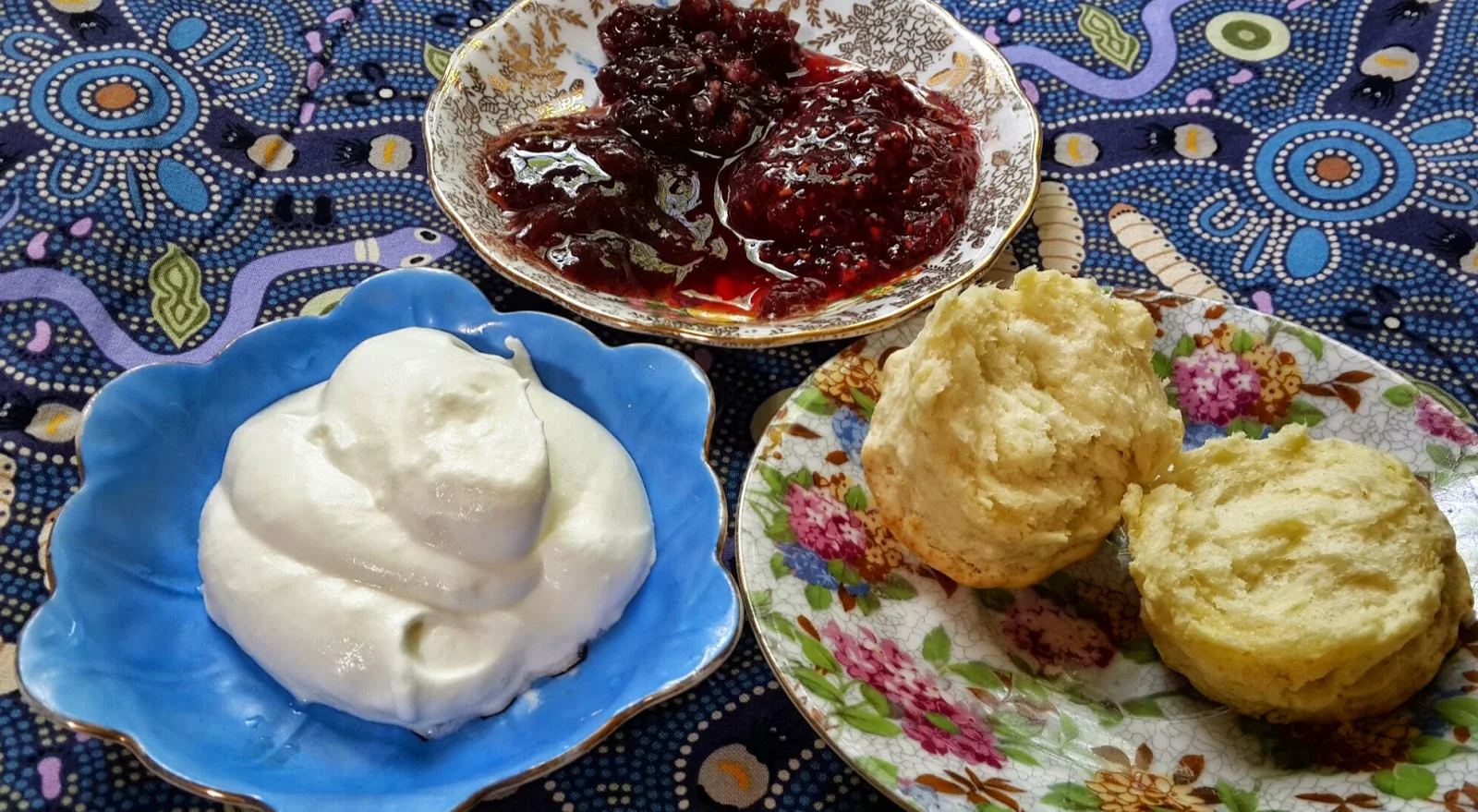Granny Kure's Scone Recipe
 |
| Hot scones with raspberry jam and whipped cream |
My mother always said that the time to pop your scones in the oven and put the kettle on for tea is as the door-bell rings to tell you your guest has arrived, particularly if their journey to see you has been long and cold.
The reality is, scones really must be made and baked fresh. Although this seems like a lot of schlep, the good news is, they are one of the easiest things to make and do not require any more specialist kitchen equipment than a bowl, a steel fork, and a baking pan and some very basic measuring equipment.
This recipe came from a book belonging to my granny, Anna Sivertsen, which predates her marriage to my grandfather. Published in 1929 and entitled Any one can Bake it was compiled by the Educational Department of the (all in caps) ROYAL BAKING POWDER CO and copyrighted to aforementioned company. They call it a biscuit, though we in South African tend to call it a scone.
Now, before you get all twitchy on me and start muttering as to how you not sure you really like scones and so on, please do understand that this is a rightly old-fashioned scone and, as such, is not to be confused with those extremely large, lumpish and doughy, misshapen, sugary, glazed objects that masquerade as scones and are even sold as such in hotels and coffee shops throughout the country.
Quite when we ever got around to modifying a perfectly good recipe and doing silly things like adding sugar to it and wiping it with egg yolk to glaze it and so on, I am really not quite sure. But the bottom-line is, those scones are really not at all what you want to eat, nor will they be what you are making. Instead, let me offer you this recipe with a refreshingly simple set of ingredients that produces a soft scone that you break by hand, and offer hot with raspberry jam and freshly whipped cream. Like so:
 |
| Scones, jam and cream |
Granny's Scone Recipe
250 grams flour (2 cups)
4 teaspoons baking powder
½ teaspoon salt
28g to 56 grams butter (2 - 4 Tablespoons butter)
180 ml milk (¾ cup)
Pre-heat oven to 250 °C (475 °F or gas mark 9). Yup, that's hot!
Time: 10 to 12 minutes
If scones had a personality, they'd be an ice maiden, best handled gingerly, if at all, and once popped into the oven they thaw with spectacular results. Bread, in comparison, is something that you fondle, pull and manoeuvre, and the warm, yeasty dough responds to all this kneading and tugging by doubling in size while still outside the oven and then needing to have its pretensions depressed at least once before zapping in to the oven. With yeast, heat kills its expansion, and locks where it is in place. With rising agents such as baking powder, though, it is the heat of the oven which causes it to rise to its full height.
Baking powder is a mixture of cream of tartar and tartaric acid, both of which are acid reactors. This means that, as the dough is mixed, it begins to rise, and it continues to rise when heated, which making it 'double acting'. But if you over-knead - sorry, knead it at all - it before it is popped in to the oven, it becomes really tough. So keeping everything cool is a good idea.
The method is remarkably simple, even a child can do it. Cut the butter into the flour mixture (flour, baking powder and salt) with a steel fork. It's not a bad idea to grate the cold butter into the flour, since you really don't want to spend too much time mashing cold butter into flour. Seriously. This is one of those times when the butter must be cold, and I sometimes pop the mixture into the fridge for a while to keep it cool since it really doesn't respond well to being hot and bothered.
 |
| Scone mixture: note the little blobs of yellow butter |
Add the milk and mix, again, with a fork only. When you have finished, you really still need to see little yellow blobs of butter interspersed in the mixture, as shown above.
There are two basic ways of forming the scone shapes.
There is this way, with a biscuit cutter, which is traditional, and a good rule of thumb to follow when flattening the scone mixture is simply to make it as high as the cutter.
The other way is simple to get it into a square-ish shape, then cut it quickly and deftly into squares.
Either way, you don't want to work with the dough too much, and keep reforming it as the dough gets tough.
Pop it into the very hot oven for 10 to 12 minutes, then take out, break apart with your fingers, and serve with jam and cream.
 |
| Hot scones fresh from the oven |



Comments
Post a Comment